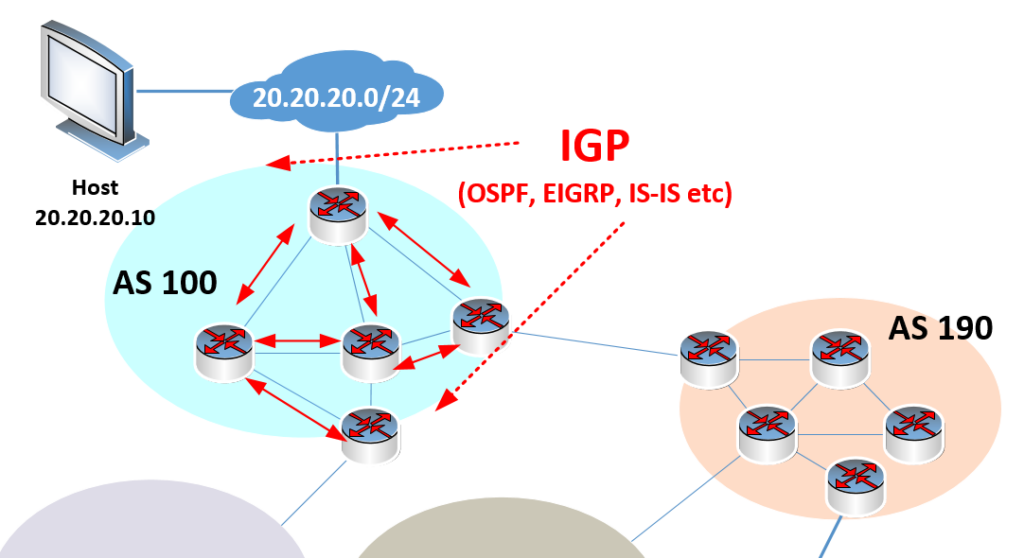Border Gateway Protocol (BGP) is widely recognized as the primary routing protocol used to exchange routing information between different autonomous systems (ASes) on the internet. However, one fundamental requirement for BGP to function correctly is that an internal routing mechanism, such as an Interior Gateway Protocol (IGP) or static routing, must already be established within an AS. This necessity often raises questions: Why does BGP, a routing protocol itself, require another routing protocol to function within an AS? Shouldn’t BGP be capable of handling all routing operations on its own?
To answer these questions, we will first define this prerequisite as established by the BGP protocol and then examine the reasoning behind it.
Routing Must Be Established Within an AS
When deploying BGP, administrators configure internal BGP (iBGP) peerings between routers within the same AS and external BGP (eBGP) peerings between routers in different ASes. For instance, in a network topology where R1, R2, and R3 are routers, R1 and R3 would establish an iBGP peering, while R1 and R2 would establish an eBGP peering.
The crucial prerequisite is that routing must be established within the AS using an IGP, such as Open Shortest Path First (OSPF) or Enhanced Interior Gateway Routing Protocol (EIGRP), or through static routing. This ensures that all routers within the AS can reach each other. In our example, if AS 100 contains multiple routers, an IGP must be configured to allow seamless communication between them.
The primary reason for this requirement is that iBGP necessitates a full mesh peering within an AS. This means every iBGP router in the AS must establish a direct BGP peering with every other iBGP router. Without an underlying IGP or static routing, routers may not be able to reach each other, and iBGP peering would fail.

Understanding the Role of BGP
The requirement for an IGP within an AS may seem counterintuitive at first. Since BGP itself is a routing protocol, why does it need another routing protocol to facilitate its operation? The answer lies in the distinct responsibilities of BGP and IGP.
From an AS’s perspective, BGP is responsible for handling external route advertisements, not internal routing. More specifically:
- eBGP is used to exchange routing information between different ASes.
- iBGP is used to distribute external routes within an AS.
For example, in our network diagram, R1 learns about the 30.30.30.0/24 network from R2 via eBGP. R1 then propagates this information to other routers within AS 100 using iBGP. Since iBGP requires full mesh connectivity, every router in AS 100 must establish an iBGP peering with all other iBGP routers to ensure that the external route information is properly distributed.
However, BGP does not handle internal routing within the AS. That responsibility falls to an IGP or static routing, ensuring that all routers can communicate effectively. Without an IGP, iBGP routers might not be able to reach each other, preventing route updates from being shared correctly.
The Hierarchical Approach of BGP and IGP
BGP follows a hierarchical routing approach where IGPs manage internal routing while BGP handles external route advertisement. This design provides efficiency and scalability.
Although it is technically possible to use BGP for internal routing, it is not a common or recommended practice. BGP is much slower in convergence than IGPs, which can lead to network instability or unexpected routing behaviors. Therefore, IGPs are typically employed for internal routing, while BGP is reserved for managing external connectivity.
In some special cases, BGP may be used for internal routing, such as in large-scale data centers or specific enterprise networks. However, this requires careful configuration and is not considered best practice under normal circumstances.
Summary
To summarize:
- An IGP or static routing must be established within an AS before BGP can function correctly.
- iBGP requires a full mesh of iBGP peerings to operate, which necessitates underlying internal routing.
- BGP’s primary role is to manage external routes, while IGPs handle internal routing.
- Although BGP can be used for internal route advertisement, it is not typically recommended due to its slower convergence and complexity.
By understanding these principles, network administrators can design more efficient and stable routing architectures, ensuring that BGP operates as intended within an autonomous system.
Also read: BGP Attributes and Determining the Best Path
About:
Welcome to telecomTech, where telecom and networking technologies… are simply explained! I’m Lazarus, a telecom professional with over 25 years of experience in network design, architecture, and telecom technologies. Over my career, I’ve led major projects, trained professionals, and helped countless individuals earn certifications and advance their careers.
My goal is to make networking and telecom concepts clear, practical, and engaging—the way I wish they were taught when I started learning!
Whether you’re a student, a professional growing your skills, or preparing for certifications like Cisco, telecomTech is here to guide you.
Join me as we explore telecom and networking as a lifelong passion, not just a job. Let’s make this journey of growth and discovery together!

